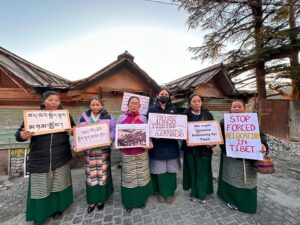THE TRADITIONAL WAY OF LIFE FOR TIBETAN NOMADS ARE IN DANGER
THE TRADITIONAL WAY OF LIFE FOR TIBETAN NOMADS ARE IN DANGER BECAUSE OF THE NOMADIC DISPLACEMENT POLICIES IMPLEMENTED BY THE CHINESE AUTHORITY IN GUISE OF PRESERVATION OF TIBET’S ENVIRONMENT.
Tibetan nomads or Drokpa have lived in perfect harmony with their surroundings. They have been taking care of or protecting the vast grasslands of Tibet as through their traditional way of life. These pastoral nomads constantly move from one place to another to find the best grazing grounds for their herds of yaks, sheep, goats and horses. The Chinese government have presented a fabricated narrative to the world that Tibetan nomads have caused untold damage to the vast grasslands and destroyed the natural habitat of the area, pinning the blame on them for erosion and gradual desertification in the area supposedly caused by the nomad’s animals’ grazing, which is far from the actual truth.
Tibetan nomads have lived an eco-friendly and self-sufficient life spread out on the vast grasslands of the plateau. The Chinese government has removed more than two million nomads from their land and pushed them into large-scale cantonments with no medical, educational or business opportunities that prevent them from leading a sustainable and dignified life as they did through generations. At the same time, such measures threaten their identity. Nomads are being forced off the land and moved into urban settlements as traditional farming methods are being replaced. Tibetan nomads face poverty, unemployment and social exclusion as their traditional way of life is ripped from their hands. Relocated families are forced to pay three-quarters or more of the cost of their new, lower quality housing. This forces them into debt, making them unable to feed their livestock or families. The relocated Tibetan nomads whom China refers to as ‘ecological migrants’ are people who have become refugees in their own land, owing to China’s reckless exploitation of Tibetan resources.
Raising yaks and other livestock has been a way of life in Tibet for centuries. Nomadic herders range across the Tibetan plateau, using their intimate knowledge of the landscape to find the best grazing for their animals and sustain their families and communities. Such practice is ecologically sustainable and has helped to maintain a healthy ecological balance of the plateau through centuries. Since the early 1990s, China has sought to destroy this way of life.
China has now moved millions of Tibetan nomads from their traditional grasslands to urban settlements, opening their land for the extraction of resources and ending traditional agricultural practices which have sustained and protected the Tibetan environment for centuries.




